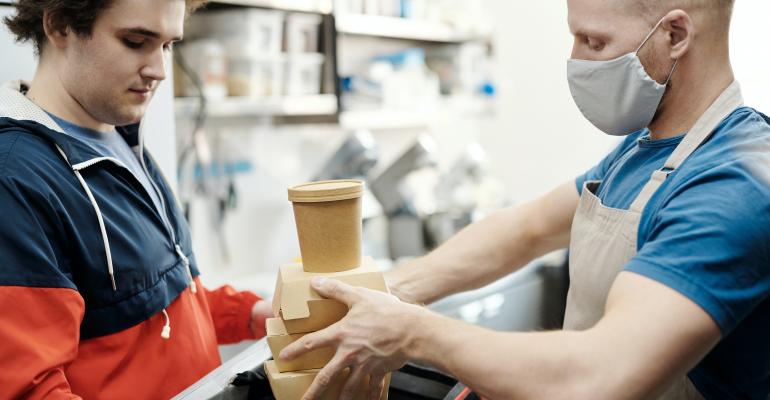Sponsored by DoorDash
The coronavirus pandemic didn’t draw customers’ attention to restaurant delivery, but it definitely boosted demand for it.
According to a 2020 National Restaurant Association survey of 3,500 restaurant operators, since coronavirus lockdowns began in March of 2020, 44% began using third-party delivery or added in-house delivery. Not surprisingly, 71% of those operators say off-premises sales are much higher than prior to the pandemic.
This trend also isn’t expected to change either. And according to Mintel Insights, that shift bodes well for third-party delivery companies. The data research firm’s long-term forecast (2022-2025) predicts restaurant “online ordering, takeout and delivery services will see increased long-term usage as a result of the pandemic. Some consumers used these services for the first time during the pandemic, and some will feel more comfortable using them moving forward.”
Similar thoughts were on the minds of Smokey Bones’ executives when responses to the pandemic halted dine-in options in March. While the 61-unit smoked-meats chain had built solid off-premises sales before 2020, those sales lagged dine-in transactions. That mix changed quickly as the virus spread across the U.S., and by July, 80% of Smokey Bones’ sales had shifted to off-premises. Some 30% of those were delivery orders.
“Our business model converted to an off-premises-only strategy overnight,” says Nicole Milnthorpe, chief financial officer of the Aventura, Florida-based company.
Adjusting to individual markets
Fortunately, the company had already established a partnership with DoorDash, a third-party online-ordering and delivery company. With best practices for delivery already in place, Smokey Bones’ new challenge was adjusting to the sheer volume of delivery orders. And with restaurants in 16 markets, it needed to adjust to each markets’ unique customer preferences. According to Milnthorpe, DoorDash’s extensive customer database was an immensely helpful tool.
“Knowing how to customize to each market has been a key driver of our success with DoorDash,” Milnthorpe says. “Their data-driven approach allowed us to make some strong financial decisions very quickly.”
That includes streamlining its takeout menus, testing region-specific marketing strategies and analyzing which items were most popular in each market. Not only did those tactics work, but they also helped more than double Smokey Bones' off-premises sales year-over-year.
Growing strategically
“They’ve been a tremendous partner, and I know we’ll continue to grow and evolve together,” says Milnthorpe. “Going forward, off-premises and dine-in will remain primary business strategies. Coupled with an emphasis on digital technology, these will be the new normal in casual dining.”
Andy Hooper, chief operating officer at 40-unit &pizza in Washington, also credited DoorDash’s deep-data stores with helping the chain grow strategically.
In 2019, &pizza wanted to build three mobile kitchens to serve as sourcing hubs that would improve delivery speed and service in underserved locations. DoorDash helped the chain pinpoint the locations of those kitchens using customer analytics.
According to Hooper, from 2018-2019, &pizza grew from five stores to 29 with DoorDash’s help. Year-over-year sales growth also surged 372% during the period.
“I think off-premises makes a whole lot of sense to people—it’s been a major part of the pizza experience for decades,” Hooper says. “COVID-19 is accelerating the trends of the restaurant industry, moving us into a world we were likely headed anyways—and delivery is here to stay.”
Rethinking operations
Like many restaurants, Yolk, a 16-unit breakfast concept, saw its sales fall as the pandemic took hold in spring. According to Gianluca Pesce, director of communications and marketing at Yolk, when customers accustomed to dine-in experiences stopped coming, the company got busy thinking of ways to bring the food to them.
“We had customers come from the suburbs all the time to dine with us, and now suddenly they’re not coming anymore,” Pesce says. “We opened up these kitchens so we could still provide those areas with the food we’re known for.
To serve its suburban Chicago customers, Yolk opened two delivery-only virtual kitchens. But that solved only part of the problem since the chain has locations in five cities. Pesce says the logical choice to was to use DoorDash to grow delivery sales in those areas also.
“We really wanted to partner with a national third-party platform that could deliver across all of our markets at the same time,” says Pesce.
If your restaurant’s sales could benefit from increased off-premises transactions, there’s no better time to leverage the technical and delivery strengths of DoorDash, the nation’s largest third-party delivery company. DoorDash is so confident your transactions will grow substantially using its leading-edge marketing services and delivery teams, it is offering its services for 30 days commission free. Visit DoorDash's website, sign up and give it a try.



